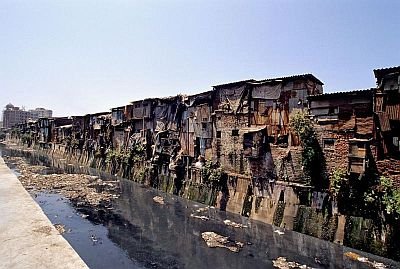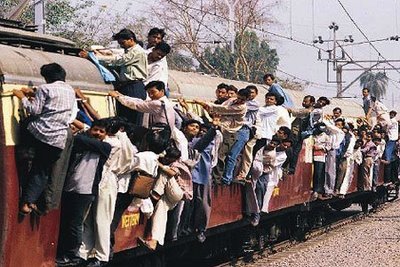What are Slums? How and where do slums develop?
In the last few decades, there had been a tremendous growth in emerging countries like India, Brazil, Mexico and China. This had been mainly due to a rapid expansion in the manufacturing sector. Thus, there has been a massive migration of workers to cities and production centers. These new workers cannot afford housing. This is what gives rise to slums, as the homeless make temporary shelters which get transformed rapidly into semi-permanent housing colonies. People migrate to cities because the comparative poverty and hardship involved in their alternatives (ie. subsistence farming) is worse.

According to UN-HABITAT, a slum is defined as a run-down area of a city characterized by substandard housing and squalor and lacking in tenure security. It is estimated that one billion humans live in shanty towns. One in every three people in the world will live in slums within 30 years unless governments control unprecedented urban growth, according to a UN report.
Europe faced the same problem of slums during the Industrial Revolution and after World Wars. Due to the rising population, the number of slum dwellers is rising. One billion people worldwide live in slums and the figure will likely grow to 2 billion by 2030. Slums have been a major problem in Mumbai, Mexico City and Sao Paolo. 55% of the population of Mumbai live in slums, which cover only 6% of the city’s land. Slum growth rate in Mumbai is greater than the general urban growth rate.
Migration brought the proportions needed to expand the economy of these cities. The reason these slums come up is that there is a severe lack of public transportation in developing countries. Cheaper accommodation is available very far from the centers of production, but the workers cannot travel so far. Hence, slums were formed very close to the industrial areas.

Another major hurdle in providing cheap accommodation to worker class is the arbitrarily set FSI (Floor Space Index) limit set my municipalities, which create an artificial shortage of housing units, thus raising its costs. Poor migrants have no place to go other than to live in slums.
Slums are semi-permanent shacks which provide housing to the poor. They are unplanned, and thus lack drainage and drinking water facilities. This might lead to piling up of excrement and garbage. There is no electricity either, but is generally stolen by hooking wires to electrical poles. Add to it, there is an increased strain on the limited infrastructure and resources of the region, which might lead to deterioration of services.

The governments have taken efforts to eradicate the problem of slums but their efforts haven’t had a major positive impact. Poverty and hunger forces people to migrate to wherever they can make a living. You cannot stop free movement of people. No city in history worth remembering has ever prospered by closing its doors and denying itself to those who seek it.
In the article Urbanization: A Majority in Cities, UNFPA says,
The world is undergoing the largest wave of urban growth in history. In 2008, for the first time in history, more than half of the world’s population will be living in towns and cities. By 2030 this number will swell to almost 5 billion, with urban growth concentrated in Africa and Asia.
Government-subsidized public housing
Slums have become breeding grounds for unlawful activities and criminals due to lack of opportunities and a vast disparity in the standards of living of people. As more and more rural folks migrate to cities, the problems would only exacerbate. Government-subsidized public housing is not the solution. Government subsidies have worsened the problems of slums as they attract new people looking for free homes.
Rent Control laws do not work either. They worsen the situation by artificially lowering the rents. This does not make homes more affordable to slum dwellers, but in fact increases its consumption and reduces supply as new projects would not be undertaken where the return on investment is low or negative.
Sometimes, the government steps in and says that rents shall not exceed “xx dollars” a month. The consequence of such indirect housing subsidy, of course, is that those tenants who are most fortunate will expand into living quarters more spacious than they would consider necessary at the competitive market price. Most tenants who can find two rooms for the price of one will occupy the two rooms instead of one.
Slum clearing campaigns periodically throw tens of thousands out of their only shelter, while planning agencies and state land ownership makes the production of adequate housing impossible.
The solutions to these problems as I see it are…
- Development of industrial areas in smaller towns and help in their development so people don’t have to migrate to large cities.
- Improvement in local transportation so that people can spread outwards instead of living near production centers.
- Revocation of FSI limits and Rent Control acts which impose undue shortages of housing and thus force the formation of slums.

AS an additional solution it requires that the government would allocate a fund to have relocation and a housing loan that could afford by the individual or let us improve their houses to make it a better place to stay.
The government should provide low cost relocation sites for informal settlers. The site must be in full package so that they don’t need to worry of having the electricity, water and other necessities.
I don’t really agree. It might seem like the right thing to do, but in my opinion, government should not get involved. If freebies are involved, then the problem would grow instead of being solved.
No more freebies and handouts. Let the private sector build low-cost housing for the slum dwellers…
You are right Benzulk. Freebies will never be a viable solution. The private sector could make a lot of money if they dedicate their resources to helping these people.
the govt should give more employment oppourtunities as they can reduce poverty and can reduce the growth of slums
The government can’t do anything productive. These people should be trained to work productively in a private sector…
c if ur providing development programmes to private sector they definetly are going to give high rents to this poor ppls . no private sector can afford a loss only govt can afford loss. next thing world bank or any other organisation like WHO wont directly provide funds to private sector they provide it to govt always
bottom line is private sector will alwys think of profit whereas even if corruption there in govt they do atleast somthing which these ppls can afford
How do you keep 90% of the world from becoming slaves to the other 10%?
Think deeper. longer term.
Well you don’t have to because you can’t. Your job is to think in a creative perspective and set things right and make world a better place where the suffering lessens…! Creation of a new world where all sections of society can live together in peace, harmony and comfort.
Cheers 🙂
I have to do a live case study on lig housing, so please help me out if there are any literature case study done on lig housing. Please post it on blog. thank you